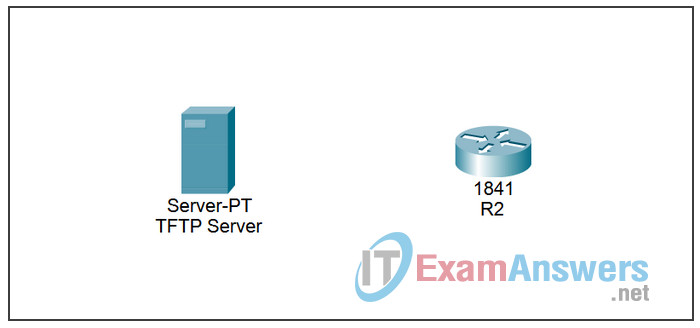4.5.4 Packet Tracer – Using a TFTP Server to Upgrade a Cisco IOS Image Answers
Topology

Learning Objectives
- Verify the current Cisco IOS image.
- Configure access to the TFTP server.
- Upload a new Cisco IOS image.
- Configure the boot system command.
- Test the new Cisco IOS image.
Introduction
In this activity, you will configure access to a TFTP server and upload a newer, more advanced Cisco IOS image. Although Packet Tracer simulates upgrading the Cisco IOS image on a router, it does not simulate backing up a Cisco IOS image to the TFTP server. In addition, although the image you are upgrading to is more advanced, this Packet Tracer simulation will not reflect the upgrade by enabling more advanced commands. The same Packet Tracer command set will still be in effect.
Task 1: Verify the Current Cisco IOS Image
Step 1. Use the show version command to verify the image currently loaded in RAM.
R2# show version Cisco IOS Software, 1841 Software (C1841-IPBASE-M), Version 12.3(14)T7, RELEASE SOFTWARE (fc2) Technical Support: http://www.cisco.com/techsupport Copyright (c) 1986-2006 by Cisco Systems, Inc. Compiled Mon 15-May-06 14:54 by pt_team ROM: System Bootstrap, Version 12.3(8r)T8, RELEASE SOFTWARE (fc1) System returned to ROM by power-on System image file is "flash:c1841-ipbase-mz.123-14.T7.bin" <output omitted>
The image currently loaded in RAM does not support SSH or many other advanced features.
Step 2. Use the show flash command to verify any images currently available in flash.
R2# show flash System flash directory: File Length Name/status 1 13832032 c1841-ipbase-mz.123-14.T7.bin [13832032 bytes used, 18682016 available, 32514048 total] 32768K bytes of processor board System flash (Read/Write)
Only one Cisco IOS image is available. Before you can use SSH and additional security features, you must upgrade the image to a more advanced version.
Task 2: Configure Access to the TFTP Server
R2 needs to establish a connection to a TFTP server that has the Cisco IOS image you need.
Step 1. Connect the Fa0/1 interface on R2 to the TFTP server.
Step 2. Configure R2 with IP address 192.168.20.1/24.
Step 3. Configure the TFTP server with IP address 192.168.20.254/24 and a default gateway.
Step 4. Test connectivity.
R2 should be able to successfully ping the TFTP server. If not, check your cabling and addressing.
Step 5. Check results.
Your completion percentage should be 80%. If not, click Check Results to see which required components are not yet completed.
Task 3: Upload a New Cisco IOS Image
Step 1. Check the TFTP server for Cisco IOS images.
Click TFTP Server and then the Config tab. Next, click the TFTP tab. Notice that there are several images available. You will upload the c1841-ipbasek9-mz.124-12.bin image to R2.
Step 2. Upload the c1841-ipbasek9-mz.124-12.bin image to R2.
- On R2, begin the upload process with the copy tftp flash command.
- Enter the IP address for TFTP Server.
- Enter the entire filename of the Cisco IOS image.
R2# copy tftp flash Address or name of remote host []? 192.168.20.254 Source filename []? c1841-ipbasek9-mz.124-12.bin Destination filename [c1841-ipbasek9-mz.124-12.bin]? Enter Accessing tftp://192.168.20.254/c1841-ipbasek9-mz.124-12.bin... Loading c1841-ipbasek9-mz.124-12.bin from 192.168.20.254: !!!!!!!!!!!!!!!!!!!!! !!!!!!!!!!!!!!!!!!!!!!!!!!!!!!!!!!!!!!!!!!!!!!!!!!!!!!!!!!!!!!!!!!!!!!!!!!!!!!! !!!!!!!!!!!!!!!!!!!!!!!!!!!!!!!!!!!!!!!!!!!!!!!!!!!!!!!!!!!!!!!!!!!!!!!!!!!!!!! !!!!!!!!!!!!!!!!!!!!!!!!!!!!!!!!!!!!!!!!!!!!!!!!!!!!!!!!!!!!!!!!!!!!!!!!!!!!!!! !!!!!!!!!!!!!!!!!!!!!!!!!!!!!!!!!!!!!!!!!!!!!!!!!!!!!!!!!!!!!!!!!!! [OK - 16599160 bytes] 16599160 bytes copied in 13.047 secs (284682 bytes/sec) R2#
Step 3. Verify that the new image is now in flash.
R2# show flash System flash directory: File Length Name/status 1 13832032 c1841-ipbase-mz.123-14.T7.bin 2 16599160 c1841-ipbasek9-mz.124-12.bin [30431192 bytes used, 2082856 available, 32514048 total] 32768K bytes of processor board System flash (Read/Write) R2#
Step 4. Check results.
Your completion percentage should be 90%. If not, click Check Results to see which required components are not yet completed.
Task 4: Configure the boot system Command
By default, the router bootup sequence loads the first Cisco IOS image listed in flash. One way to make sure that the router loads the new image is to configure the boot system flash command. On R2, enter the following command:
R2(config)# boot system flash c1841-ipbasek9-mz.124-12.bin
This command is now part of the running configuration. However, the running configuration must also be saved to NVRAM; otherwise, the configuration is overwritten the next time you reload the router.
R2(config)# end R2# copy running-config startup-config
Your completion percentage should be 100%. If not, click Check Results to see which required components are not yet completed.
Task 5: Test the New Image
Reload R2 and wait for it to reboot. When the router reloads, verify that the new image is in RAM with the show version command.
R2# reload Proceed with reload? [confirm][Enter] %SYS-5-RELOAD: Reload requested by console. Reload Reason: Reload Command. <output omitted> R2>show version Cisco IOS Software, 1841 Software (C1841-IPBASEK9-M), Version 12.4(12), RELEASE SOFTWARE (fc1) Technical Support: http://www.cisco.com/techsupport Copyright (c) 1986-2006 by Cisco Systems, Inc. Compiled Mon 15-May-06 14:54 by pt_team ROM: System Bootstrap, Version 12.3(8r)T8, RELEASE SOFTWARE (fc1) System returned to ROM by power-on System image file is "flash:c1841-ipbasek9-mz.124-12.bin" <output omitted>
